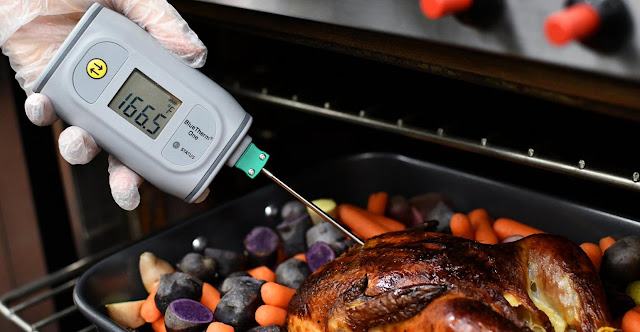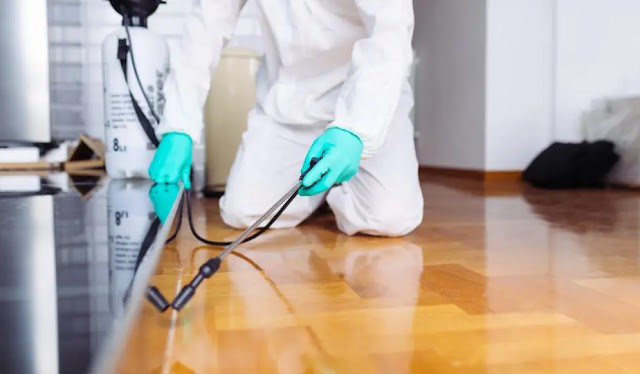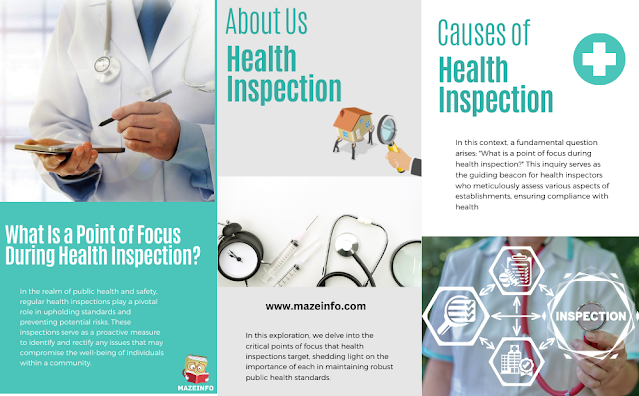In the realm of public Health and safety, regular health inspections play a pivotal role in upholding standards and preventing potential risks. These inspections serve as a proactive measure to identify and rectify any issues that may compromise the well-being of individuals within a community. In this context, a fundamental question arises: “What is a point of focus during health inspection?”
This inquiry serves as the guiding beacon for health inspectors who meticulously assess various aspects of establishments, ensuring compliance with health regulations and fostering environments conducive to the overall health and welfare of the public. In this exploration, we delve into the critical points of focus that health inspections target, shedding light on the importance of each in maintaining robust public health standards.
Hygiene and Sanitation
Health inspections related to hygiene and sanitation are crucial for ensuring the Food safety and well-being of individuals in various settings, such as restaurants, food establishments, healthcare facilities, and public spaces. Here are key aspects related to hygiene and sanitation that health inspectors typically assess:
Food Handling Practices
Ensure that all personnel involved in food handling follow proper hygiene and safety measures including regular handwashing with soap and water. Use separate cutting boards and utensils for raw and cooked foods to prevent cross-contamination.
Implement proper cooking temperatures to ensure that food processing is cooked thoroughly and is safe for consumption. Regularly monitor and record food storage temperatures to prevent bacterial growth and spoilage.
Cleanliness of Food Preparation Areas
Maintain a clean and organized kitchen environment to prevent the build-up of dirt, grease, and other contaminants. Regularly clean and sanitize Food hygiene preparation surfaces, equipment, and utensils to minimize the risk of foodborne illnesses. Ensure that cleaning schedules are in place and followed, and that cleaning supplies are stored appropriately.
Personal Hygiene of Staff
Enforce strict personal hygiene practices among staff, including the use of hairnets, gloves, and appropriate work attire. Train employees on the importance of staying home when sick to prevent the spread of illnesses. Provide designated areas for employees to store personal items and change into work attire to prevent cross-contamination.
Proper Waste Disposal
Establish a proper waste disposal system to ensure the timely and sanitary removal of food waste and garbage. Use covered trash containers to prevent the attraction of pests. Regularly schedule waste disposal and recycling pickups to maintain a clean and odor-free environment.
Temperature Control

Temperature control is a critical aspect of health inspections in various industries, ensuring the safety and quality of products that directly impact public health. Maintaining appropriate temperatures is essential in environments such as restaurants, food processing facilities, and healthcare settings. Refrigeration and heating systems must be diligently monitored and calibrated to adhere to specific guidelines and regulations. In the food industry, for instance, low carb diet refrigeration units are crucial in preventing the growth of harmful bacteria and ensuring the freshness of perishable items.
Improper temperature control can lead to the proliferation of pathogens, posing significant risks to consumers. Health inspectors pay close attention to temperature records, storage practices, and the functionality of cooling and heating equipment during their inspections. Rigorous temperature control not only safeguards the integrity of products but also demonstrates a commitment to public health and regulatory compliance. Establishments that prioritize and maintain proper temperature control measures are better equipped to protect the well-being of consumers and uphold the standards set by health authorities.
Also, Read More: Technology in Cricket : 100 Years of Evolution & What’s Next?
Cross-Contamination Prevention
Certainly! Cross-contamination prevention is crucial in maintaining food safety and passing healthy snacks inspections. Here are three important points related to cross-contamination prevention:
Separation of Raw and Cooked Foods
One critical aspect of preventing cross-contamination in a food establishment is maintaining a strict separation between raw and cooked Food hygiene . This involves using separate cutting boards, utensils, and preparation areas for raw meats, poultry, and seafood to avoid the transfer of harmful bacteria to ready-to-eat foods. Adequate spacing in refrigerators and storage areas is also essential to prevent any inadvertent contact between raw and cooked items.
Proper Hand Hygiene Practices
Effective hand hygiene is paramount in preventing the spread of contaminants in a foodservice environment. Food handlers must consistently wash their hands thoroughly with soap and water, especially after handling raw food processing, using the restroom, or touching any potentially contaminated surfaces. The availability of handwashing stations and the provision of hand sanitizers in key areas within the facility can significantly contribute to maintaining a hygienic environment and minimizing the risk of cross-contamination.
Regular Cleaning and Sanitization Protocols
Implementing routine and thorough cleaning practices is crucial to minimize the risk of cross-contamination. All surfaces, equipment, and utensils that come into contact with food should be regularly cleaned and sanitized. This includes cutting boards, countertops, knives, and any machinery used in food preparation. Establishing a detailed cleaning schedule anti inflammatory diet and ensuring that cleaning supplies are easily accessible to staff are essential components of a comprehensive strategy to prevent cross-contamination and maintain a safe and hygienic food handling environment. Regular training and monitoring of staff to ensure compliance with these protocols further strengthen the overall effectiveness of cross-contamination prevention measures.
Pest Control

Pest control is a critical aspect of health inspections, particularly in food establishments and healthcare facilities where the presence of pests can pose serious health risks. Health inspectors often pay close attention to pest control measures to ensure that businesses maintain a clean and safe environment. Here are some key points related to pest control in the context of health inspections:
Integrated Pest Management (IPM): Health inspectors look for evidence that businesses have implemented an Integrated Pest Management program. IPM is a comprehensive approach to pest control that combines various strategies such as sanitation, exclusion, monitoring, and the judicious use of pesticides.
Sanitation Practices: Proper sanitation is crucial in preventing and controlling pests. Inspectors check for cleanliness in and around the facility, including proper waste management, cleaning schedules, and the elimination of superfoods debris that may attract pests.
Exclusion Measures: Health inspectors assess how well businesses prevent pests from entering their premises. This includes checking for gaps or cracks in walls, doors, and windows that pests could use to gain access. Ensuring that doors and windows have proper seals is an important aspect.
Storage Practices: Proper storage of food items is essential to prevent pest infestations. Inspectors may check for the use of airtight containers, proper shelving, and appropriate storage temperatures to deter pests.
Pesticide Usage: If pesticides are used, healthy meals inspectors will want to ensure that they are used according to regulations. This includes proper application, storage, and documentation of pesticide usage. Businesses are often encouraged to use non-chemical methods whenever possible.
Monitoring and Documentation: Regular monitoring for signs of pests and keeping accurate records of pest control activities are important. Businesses should have documentation of pest control measures taken, including inspections, treatments, and any corrective actions.
Employee Training: Staff members should be trained in recognizing and reporting signs of pest activity. Training programs should cover proper sanitation practices and the importance of maintaining a pest-free environment.
Prompt Corrective Action: If pests are detected, health inspectors want to see evidence of prompt corrective action. This may include immediate treatment, identification of the source of the infestation, and implementation of measures to prevent future occurrences.
Allergen Management

Certainly, effective allergen management is crucial in the food industry to ensure the safety of consumers, as allergies can have severe consequences. Here are five important points related to allergen management for health inspections:
Allergen Identification
Clearly identify and label all allergens present in the facility’s ingredients and finished products. Ensure that staff members are well-trained to recognize and understand the significance of allergen information.
Cross-Contamination Prevention
Implement strict measures to prevent cross-contamination between allergenic and non-allergenic ingredients during storage, preparation, and cooking care. Use separate utensils, equipment, and work surfaces for handling allergenic ingredients, or thoroughly clean and sanitize shared equipment.
Ingredient Verification
Regularly verify the accuracy of allergen information provided by suppliers. Ensure that the information is up-to-date and reliable. Maintain a system for tracking and updating ingredient information, especially when there are changes in suppliers,cacfp or product formulations.
Staff Training
Provide comprehensive training to all staff members regarding allergen awareness and management. Ensure that staff is educated on the importance of preventing cross-contact, proper labeling, and the severity of allergic reactions.
Communication
Establish clear communication protocols between kitchen staff, waitstaff, and management regarding allergen information. Clearly communicate allergen information to customers, either through menu labeling, verbal communication by staff, or other means, to help customers make informed choices.
Staff Hygiene and Training
Maintaining rigorous standards of staff hygiene and providing thorough training are pivotal components of a successful health inspection protocol in any establishment, particularly in industries such as food service and unitedhealth care. Staff hygiene plays a critical role in preventing the spread of infections and ensuring the well-being of both employees and customers. Regular handwashing, proper use of personal protective equipment, and adherence to uniform and grooming standards are fundamental aspects that contribute to a hygienic work environment.
Equally important is the implementation of comprehensive training programs for staff members. Training should encompass not only basic hygiene practices but also an understanding of health and safety regulations, food handling protocols, well care and emergency response procedures. This not only promotes a culture of responsibility and accountability among employees but also equips them with the knowledge and skills necessary to maintain a clean and safe workplace. Continuous training ensures that staff members stay updated on the latest health and safety guidelines, fostering a proactive approach to compliance.
Documentation and Record Keeping

Maintaining proper documentation and record-keeping is crucial in the context of health inspections, as it helps ensure compliance with regulations, track trends, and demonstrate a commitment to safety and hygiene. Below are some key aspects of documentation and record-keeping related to health inspections:
Cleaning and Sanitizing Records
- Keep detailed records of cleaning schedules, including the cleaning agents used, concentrations, and methods.
- Maintain records of sanitization processes for equipment and surfaces.
- Document any corrective actions taken in response to sanitation issues.
Temperature Logs
- Record temperatures of refrigerators, freezers, and hot holding units regularly.
- Note any temperature variations and the corrective actions taken.
- Ensure that food items are stored at the appropriate temperatures.
Employee Training Records
- Maintain records of employee training in food safety and hygiene.
- Document ongoing training sessions and certifications.
- Include records of any additional health-related training, such as COVID-19 protocols.
Food Source and Supplier Records
- Keep records of food sources and suppliers, including contact information.
- Document inspections of incoming food shipments, medi care and any issues identified.
- Retain certificates of analysis for food items, if applicable.
Pest Control Records
- Document pest control measures, including the types of pests targeted and methods used.
- Keep records of any pest sightings and actions taken to address the issue.
HACCP (Hazard Analysis and Critical Control Points) Documentation
- Maintain HACCP plans, including hazard analysis, critical control points, and monitoring procedures.
- Document any changes to the HACCP plan and the reasoning behind them.
Allergen Control Records
- Keep records of ingredients and potential allergens in each menu item.
- Document procedures for preventing cross-contamination and managing allergen risks.
Equipment Maintenance Records
- Keep records of equipment maintenance schedules and performed maintenance.
- Document any equipment malfunctions and the actions taken to repair them.
Conclusion
Health inspections serve as a critical mechanism for safeguarding public health by assessing and ensuring compliance with established safety standards. The focal point of these inspections revolves around identifying potential hazards, enforcing hygiene protocols, and verifying the overall adherence to regulations within various establishments. The culmination of these efforts contributes to the prevention of foodborne illnesses, maintenance of sanitary conditions, and the promotion of a healthier environment for both consumers and employees. By emphasizing continuous improvement and adherence to best practices, health inspections play an indispensable role in fostering a safer and more secure community through the regular scrutiny of universal health care and hygiene standards.
Frequently Asked Questions
Q: What areas are typically inspected during a health inspection?
Ans: Health inspections typically focus on key areas such as food storage, handling, and preparation areas, cleanliness and sanitation practices, employee hygiene, equipment maintenance, and overall facility conditions.
Q: How can I ensure proper food safety and handling practices?
Ans: Adhering to proper food safety guidelines involves maintaining appropriate temperatures for storage and cooking, preventing cross-contamination, practicing good personal hygiene, and regularly cleaning and sanitizing surfaces and equipment.
Q: What are the key considerations for maintaining a clean and sanitary environment?
Ans: Regular cleaning schedules, proper waste disposal, and the use of approved cleaning agents are essential. Ensuring that all surfaces, equipment, and utensils are sanitized effectively helps prevent the spread of contaminants.
Q: What measures should be in place to monitor and control pests?
Ans: Implementing pest control measures involves regular inspections, sealing entry points, proper waste management, and the use of pest control services when necessary. Maintaining a pest-free environment is crucial for food safety.
Q: How can I ensure that employees are practicing good hygiene?
Ans: Implementing pest control measures involves regular inspections, sealing entry points, proper waste management, and the use of pest control services when necessary. Maintaining a pest-free environment is crucial for food safety.
Q: What documentation is important to have in order for a health inspection?
Ans: Keeping accurate records of food temperatures, cleaning schedules, employee training, and pest control measures is essential. Having these documents readily available during an inspection demonstrates compliance with health and safety regulations.



